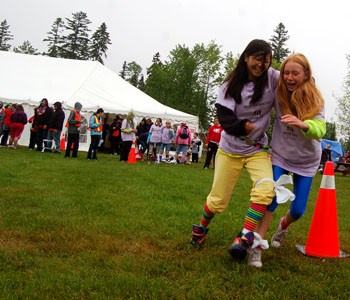With more people living in poverty every year, the role of the shelter house becomes essential in providing basic needs to the community, says the marketing and development coordinator.
The Thunder Bay Shelter House held its annual relay at Chippewa Park on Saturday. Despite the rain, the fundraising event had 27 teams of different sizes compete in different activities from three-legged races to obstacle courses. Some teams had a theme or donned costumes, such as Batman and Spider-Man. The individual teams raised money for the shelter house through fundraising events throughout the year.
Lucas Jewitt, marketing and development coordinator for Thunder Bay Shelter House, said the relay is the big event to wrap up the year. He said the shelter needed $400,000 a year to run and operate its services and added the relay usually contributed a third of what the shelter house needed.
"The relay’s success is the key to our success…fundraising wise," Jewitt said. "In my mind the shelter house is an essential service. What I found was amazing when I first started was the different stories. There are young kids, there are parents who don’t have a place to go, people laid off, people injured and can no longer work or have mental health issues."
Jewitt said the number of people who participate in the relay increase from last year and added the relay is a good way for coworkers, students or friends to bond as a group.
According to the Thunder Bay Shelter House website, about 17,000 people in Thunder Bay live in low-income situations and have inadequate social assistance, minimum wage rates and difficulties paying utilities.
The shelter house offers about 52 beds for those needing a place to stay and provides a meal service. The shelter house provides about 500 meal units a day for all three meals.
Jewitt said people tended to use the meal service more than needing a place to stay. Although, the number of people who used beds during the winter months increased, he said.
Traditionally, people spend a short time period at the shelter house until they can afford an apartment. However, most of their pay cheque goes towards paying for rent and sometimes cannot afford any food.
"They’re funded through Ontario works so their income is really low," he said. "We`ll see a lot of residences that have apartments in the community use our food service so they don’t become homeless. It is a basic needs kind of service."
Jewitt said the shelter house is stuck in a constant worst-case scenario where when the economy is poor they see an increase in the number of people using the shelter but receive less money through fundraising to help them.
"If people can’t, for whatever reason, can’t meet their basic needs then there really isn’t anywhere else for them to go," he said. "The shelter house is really a catch all for all those issues. There are a lot of issues that can lead people to becoming homeless or having low-income so the shelter is key."
Sign in or register
- Messages
- Post a Listing
- Your Listings
- Your Profile
- Your Subscriptions
- Your Likes
- Your Business
- Support Local News
- Payment History
Registered Users
Already have an account?
New Users
Create a free account.
